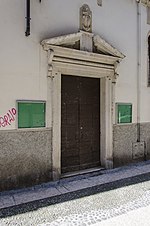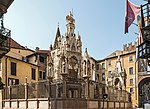Istituto Maffei

Istituto Maffei, officially called Liceo Ginnasio di Stato 'Scipione Maffei', is one of the oldest high school in Italy. It is situated in the center of Verona in northern Italy. It is a grammar school, with students who focus on the classics and can choose different paths: communication, or languages. Students who choose the first path study Latin, Ancient Greek, Mathematics, Biology, Physics, Chemistry, Philosophy, History, Geography, Italian and Italian literature, English and English literature, I.T, Law and Economy. Students who, on the other hand choose the second path study the same subjects (apart from Ancient Greek) plus some other modern languages like French, Spanish or German. It was officially founded in 1808 under the name "Liceo con Convitto", although it was actually already in operation in 1805. Then in 1867 it was renamed "Regio Liceo Scipione Maffei", after an Italian writer and art critic, author of many articles and plays.
Excerpt from the Wikipedia article Istituto Maffei (License: CC BY-SA 3.0, Authors, Images).Istituto Maffei
Via Abramo Massalongo, Verona Veronetta
Geographical coordinates (GPS) Address Phone number Website Nearby Places Show on map
Geographical coordinates (GPS)
| Latitude | Longitude |
|---|---|
| N 45.445277777778 ° | E 10.999044444444 ° |
Address
Conservatorio di Verona Evaristo Felice Dall'Abaco
Via Abramo Massalongo
37121 Verona, Veronetta
Veneto, Italy
Open on Google Maps











